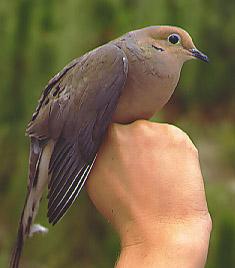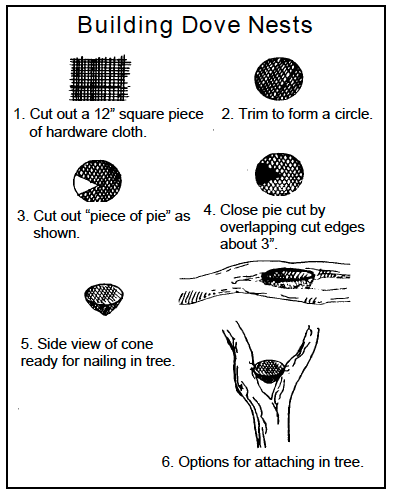Habitat Requirements
Mourning doves range across all of North Carolina and are the most abundant game bird in the Southeast. Requiring open or semi-open lands, mourning doves primarily thrive in agricultural landscapes, especially those with corn, wheat, grain sorghum, millet, sunflowers, soybeans, or peanuts. Mourning doves are seed eaters; in fact, adults feed their young protein-rich “crop milk” instead of insects. Mourning doves can travel considerable distances in search of food, water, and “grit,” but prefer easy access to these resources. The mourning dove nests in dense understory or midstory vegetation, often along wooded edges near fields, pastures, and urban areas. Because the dove is a migratory species, local habitat conditions generally do not limit the population, nor will manipulation of the environment increase regional populations. However, habitat improvement can concentrate birds, especially during the hunting season.
Food
A mourning dove's diet consists almost entirely of seeds, including those from forbs and grasses growing wild, and from grains in cultivated fields.
Mourning doves generally do not feed in areas containing densely-matted ground vegetation. Bare ground on which seeds are visible and readily available is preferred.
Care should be taken when planting food for mourning doves near areas where they are hunted. Federal regulations concerning the baiting of migratory birds prohibit the shooting of mourning doves where grains, salt, or other foods are placed (i.e. carried to an area, not grown) for the purpose of attracting birds. Any grain or grain residues resulting from normal agricultural practices or wildlife food plots may be hunted over. It is recommended that state and / or federal wildlife officers be consulted concerning plans for dove food production and hunting.
You can attract mourning doves to your yard by scattering seeds, such as millet or grass seeds, on the ground or on platform-style bird feeders. Because mourning doves spend much of their time on the ground, it is important to keep your cats inside.
| Ragweed | Pines |
| Carolina geranium | Knotweeds (Polygonum) |
| Pigweed (Amaranthus) | Native sunflower |
| Doveweeds (Croton) | Wild millets |
| Crabgrass | Foxtail grasses |
| Sedges | Pokeweed (Phytolacca) |
| Wild peas |
Cover
Nesting sites usually are not a limiting factor for mourning doves. Mourning doves typically nest in shrubs and small trees along the edges of cropland, fallow fields, or pastures, or in thinned woodlands. Nests are usually 10 to 30 feet above the ground.
Mourning Dove "Nesting Cone" Project
- Construct the nesting cone using 1⁄4-inch or 1⁄2-inch hardware cloth
- Place cone 6 to 10 feet high in a tree with considerable open space available (good choices include urban or suburban areas, or in trees along the edge of woodlands)
- Be sure the cone is positioned in a shaded area, but with room for the dove to move about without hinderances from numerous twigs or limbs
- Attach cone to the tree with wire (bend edges down slightly after it is in place)
Water
Water is an important requirement for mourning doves. Watering sources are used more frequently if bare ground is present adjacent to a portion of the water's edge.
Migration
Migratory mourning doves over-winter in the Southeast, and the greatest dove concentrations in North Carolina occur in the late summer and fall, after which many individuals move further south. Spring migration begins about February, depending on cold weather and snow. Not all mourning doves are migratory, however, and year-round residents in a local area are the first to breed in the spring.
Mourning doves reproduce at high rates, but are short-lived and generally survive less than one year. Those surviving fall migration tend to over-winter in the same area each year and remain longest in the best habitat. Wintering mourning doves prefer river and creek bottoms near agricultural fields that produced corn or grains the previous summer.
Mourning Dove Management
Tips for Improving Mourning Dove Habitat
Regeneration
- Use seed tree, shelterwood, or clearcut regeneration methods, which all create a dense understory and midstory that may be used by nesting doves. Also, doves may feed on seeds on patches of bare ground soon after harvests.
- Schedule site preparation activities prior to mid-June to produce herbaceous seeds by fall migration.
Intermediate treatments
- Thin forest stands early and frequently to stimulate herbaceous growth in the understory and to maintain high quality nesting cover.
- Burn thinned forest stands frequently (every 2 to 4 years) to retain woody and herbaceous understory.
- Schedule burns in winter months to improve herbaceous seed production. Burn in late summer or early fall to expose seeds on bare ground, especially for hunting locations.
Direct improvements
- Leave agricultural fields untilled after harvest and leave small areas unharvested to provide food for doves.
- Maintain patches of nesting cover adjacent to croplands or other feeding locations.
- Plant food plots (corn, wheat, buckwheat, millet, sunflower) in >5 acre openings, especially near high points in the landscape where doves congregate.
- Kill trees to create roosting snags along the margins of cropland and planted food plots.
Many species requiring early succession vegetation benefit from mourning dove management. Hence, management plans should also emphasize the species that are associated with early successional plant communities or young forest favored by mourning doves.
| Early Succession | Young Forest |
| Horned lark | Yellow-breasted chat |
| Goldfinch | Prairie warbler |
| Northern bobwhite | Gray fox |
| Bobolink | Eastern cottontail |
| Red fox | White-tailed deer |
Working With Wildlife
North Carolina State University Extension - Forestry
Working With Wildlife Series
Publication date: Jan. 1, 2019
Reviewed/Revised: May 28, 2024
N.C. Cooperative Extension prohibits discrimination and harassment regardless of age, color, disability, family and marital status, gender identity, national origin, political beliefs, race, religion, sex (including pregnancy), sexual orientation and veteran status.
N.C. Cooperative Extension prohibits discrimination and harassment regardless of age, color, disability, family and marital status, gender identity, national origin, political beliefs, race, religion, sex (including pregnancy), sexual orientation and veteran status.





